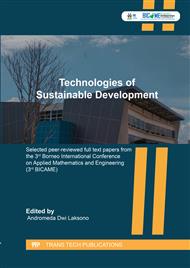p.1
p.7
p.17
p.27
p.35
p.41
p.47
p.57
Application of System Dynamics Approach for Minapolitan Area Development
Abstract:
Economic growth is influenced by regional development policies and the availability of regional resources. One policy that utilizes the potential of fisheries resources is the policy of the Minapolitan area. This policy can potentially lead to conflicts over spatial use when development is carried out without concern for the environment. This study aims to assess the variables that influence and formulate the concept of sustainable regional development. The object of this research is Lekok Regency, Pasuruan Regency, East Java, Indonesia. In this paper, introducing a system dynamic approach with consideration of the complexity of the lives of coastal communities and the variety of conflicts regarding the location and limitations of existing resources, viewed from the aspects of land, economic and social activities of the Minapolitan area development system in actual conditions.
Info:
Periodical:
Pages:
27-33
Citation:
Online since:
February 2021
Authors:
Keywords:
Price:
Сopyright:
© 2021 Trans Tech Publications Ltd. All Rights Reserved
Share:
Citation:



